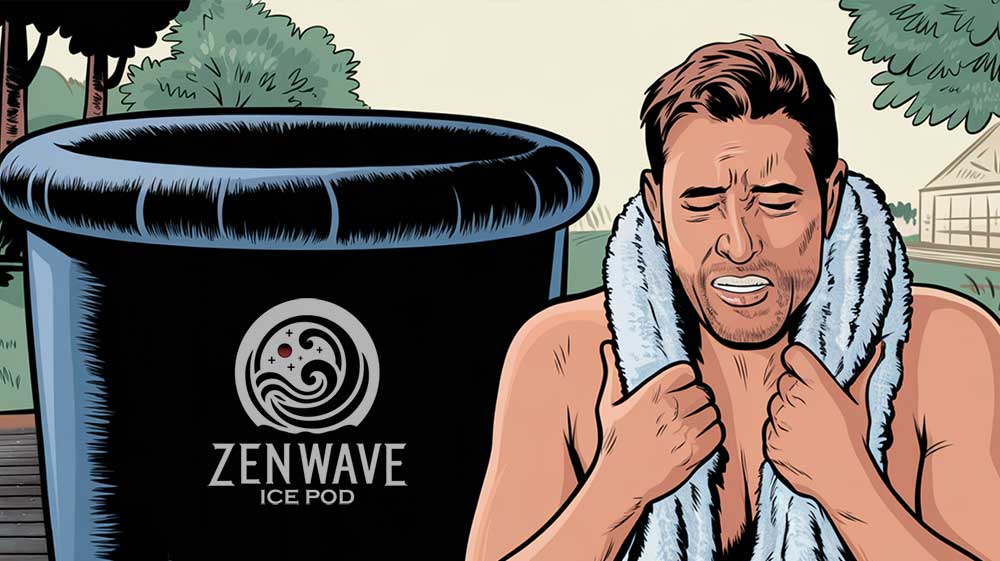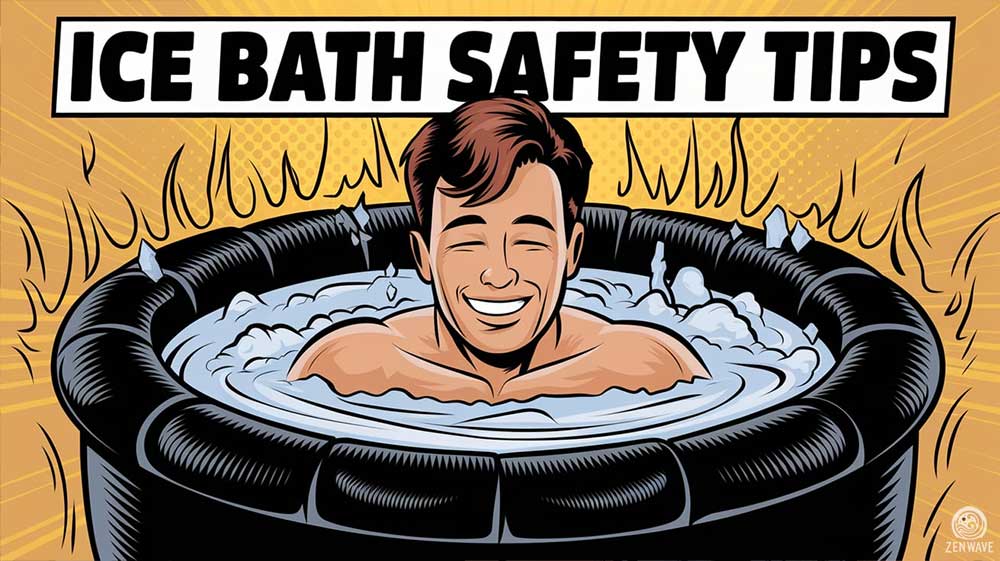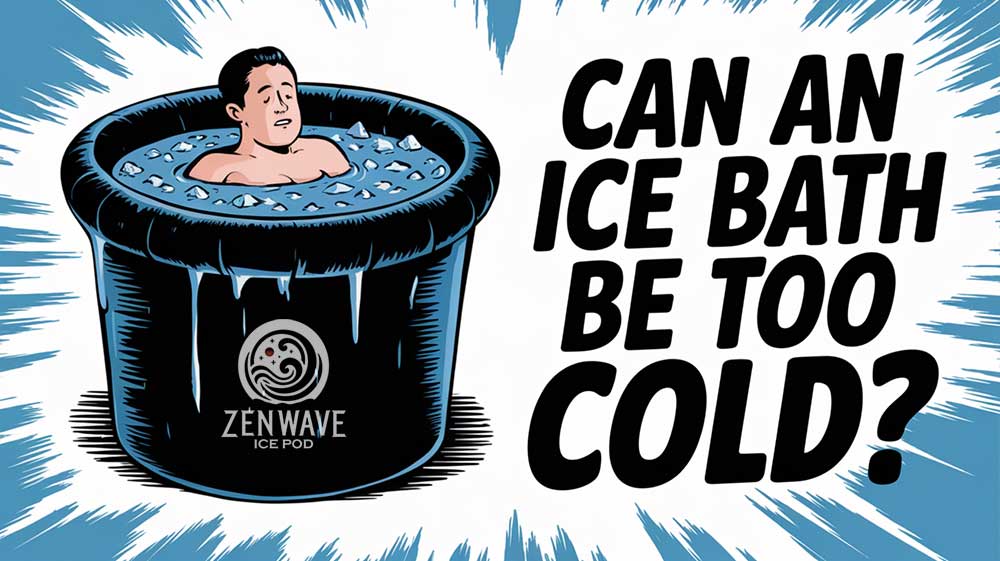Ice baths can provide incredible benefits for both your body and mind, but it’s important to understand the risks involved if the water is too cold. While ice baths are popular for muscle recovery, reducing inflammation, boosting mood, and improving focus, excessively cold water can lead to serious health issues like hypothermia or frostbite.
These risks are manageable with proper precautions and shouldn’t deter you from trying ice baths. When you understand the risks and know how to mitigate them, they become far less dangerous.
This article will help you understand the dangers of ice baths that are too cold and provide practical tips to keep your cold exposure safe and beneficial.
The Dangers of Extremely Cold Ice Baths
Hypothermia
Hypothermia happens when your body loses heat faster than it can make it, causing your body temperature to drop too low. If you stay in an ice bath that’s colder than 60°F (15.5°C) for too long, you can develop hypothermia.
Signs of hypothermia include:
- Uncontrollable shivering
- Confusion
- Clumsiness
- Trouble thinking clearly
- Passing out
Your muscles might also stop working the way they should, which can make it harder to get out of the bath safely. If your body temperature gets too low, it can be very dangerous, so it’s important to know the risks and limit your time in the ice bath.
To stay safe, always set a timer and have someone nearby to help if needed.
Frostbite
Frostbite happens when your skin and the tissues underneath it freeze. This can occur if parts of your body are in contact with extremely cold water for too long during an ice bath. Fingers, toes, and other extremities are the most at risk because they lose heat the fastest.
Signs of frostbite include:
- Numbness
- Skin that turns pale or blue
- Tingling or burning feeling
If frostbite gets bad enough, it can cause permanent damage to the skin and tissues. In severe cases, it can even lead to losing fingers or toes. To avoid frostbite, don’t stay in the ice bath too long, especially if the temperature is below freezing. Protecting your hands and feet with neoprene gloves or ice bath socks can also help.
Trouble Thinking Clearly (Brain Fog)
Being in very cold water during an ice bath can also affect how well your brain works. During extreme cold, a lot of your body’s energy goes into keeping you warm, which means there is less energy for your brain.
This can cause brain fog, making it:
- Hard to think clearly
- Difficult to remember things
- Challenging to make decisions
Usually, this brain fog goes away once you warm up, but it’s still important to be aware of the risk, especially if you need to do something that requires focus after an ice bath. If you start to feel confused or disoriented while in the ice bath, it’s a sign that you need to get out and warm up.
Remember, it’s better to cut your session short than to push yourself too far and risk your safety. The benefits of ice baths on mental health can be amazing if done correctly, but always prioritize safety and know your limits.
Muscle Stiffness and Poor Recovery
While ice baths are supposed to help muscles recover, if the water is too cold, it can make your muscles too stiff. This can actually slow down your recovery instead of helping it. Muscles that are too stiff can’t move as easily, which can make it harder to get back to exercising.
It’s important to use ice baths at the right temperature so your muscles can relax and recover properly. Overly cold water can cause muscles to contract too much, leading to increased soreness and stiffness.
To avoid this, aim for a temperature that is cold enough to reduce inflammation but not so cold that it makes your muscles overly tight.
Other Risks
Other general risks of ice baths can occur in ice baths generally, not solely because the water is too cold. However, the severity and likelihood of these risks increase with lower temperatures. These risks include:
- Stress on the Heart: Ice baths can put stress on your heart by making your blood vessels tighten, which can increase blood pressure. For people with pre-existing heart conditions, this can lead to serious problems like heart attack or stroke.
- Cold Shock Response: Entering very cold water can cause a sudden increase in breathing and heart rate, known as cold shock response. This can make you gasp involuntarily, which could be dangerous if your head is underwater.
- Non-Freezing Cold Injury: Exposure to cold for too long can damage nerves and blood vessels, causing pain, numbness, and sensitivity to cold. This type of injury can take a long time to heal and is more likely if the ice bath is too long.
- Physical Weakness: Cold exposure can make your muscles weak and uncoordinated, which can make it difficult to get out of the ice bath safely.
For a more in-depth look at all the potential risks, including those associated with warmer cold plunge temperatures, check out our article Risk of Ice Baths. This comprehensive guide will help you understand all aspects of staying safe during cold exposure therapy.
Rewarming Dangers and After Drop

After getting out of an ice bath, it is crucial to warm up properly. Failing to do so could leave you at risk for hypothermia, even after exiting the cold water. You might feel dizzy or have trouble thinking clearly while warming up, so avoid driving or operating machinery until you fully recover.
Using a sauna, warm light, or wrapping up in warm clothes can aid in a safe recovery. Drinking something warm also helps raise your core temperature. Avoid alcohol, as it gives a false sense of warmth without aiding recovery, which can increase the risk of hypothermia.
After drop is a phenomenon where your core body temperature continues to drop even after you leave the ice bath. This happens because cold blood from your skin and extremities returns to your core, further lowering your internal temperature. This can make you feel even colder and increase the risk of hypothermia.
To counteract after drop, it is essential to warm up gradually and effectively, emphasizing the importance of proper rewarming techniques. Avoid taking a shower right after an ice bath, as it can lead to further temperature fluctuations that make after drop worse.
Ice Bath Safety Tips

1. Know Your Limits and Avoid Cold Overdose
Hypothermia, frostbite, and brain fog are all signs of too much cold exposure. Start with shorter times in the ice bath and slowly work your way up. Listen to your body and stop if you feel dizzy, confused, or too cold. Everyone’s tolerance for cold is different, so find what works for you without pushing yourself to your limits.
Keep track of how your body feels during and after each ice bath to better understand your limits. It’s always better to be cautious, especially when you’re just starting out. Gradually increase your time as you get more comfortable, and remember to always prioritize safety over endurance.
2. Rewarm Properly
After getting out of the ice bath, it’s important to warm up safely. Use a sauna, warm light, or warm clothing to help your body recover. Avoid jumping into intense activities right after an ice bath while your body is still cold. Rewarming properly is key to avoiding issues like dizziness, muscle stiffness, or even hypothermia.
Take your time, and make sure you feel fully warmed up before moving on to other activities. Drinking something warm, like herbal tea, can also help speed up the rewarming process.
Be sure to follow our Post Ice Bath Warm Up Guide for detailed steps on how to safely rewarm.
3. Personal Minimum Effective Dose
Everyone has a different “minimum effective dose” for cold exposure. Research suggests that even a small amount of cold exposure each week can be enough to get benefits. Find the amount that works best for you without pushing yourself to the point of overdosing on cold.
Microdosing cold exposure—such as doing shorter ice baths more often—can be just as effective as longer sessions and might be easier for your body to handle. The goal is to get the benefits without putting yourself at risk.
4. Have a Buddy System
Always have someone nearby when you take an ice bath, especially if you’re new to cold exposure. A buddy can help you if you start to feel weak, dizzy, or have trouble getting out of the bath.
Having someone there ensures that you stay safe in case anything goes wrong.
They can also help keep track of time and make sure you don’t stay in the ice bath for too long. Even experienced users can run into trouble, so having a buddy is always a good idea.
5. Monitor Water Temperature
Keep an eye on both the temperature of your ice bath and the length of time you spend in it. The ideal temperature range is usually between 50-59°F (10-15°C), but you can adjust it depending on your experience and goals. If the water is too cold or if you stay in too long, it can increase your risk of hypothermia or other health problems.
Use a thermometer to check the temperature before getting in, and avoid temperatures below freezing. Monitoring both the temperature and the duration helps you stay in control, ensuring your ice bath is both safe and effective. You can push the temperature lower or extend your time in the bath, but always do so gradually and in a controlled manner.
Temperature can change the benefits you’ll get from an ice bath. Knowing exactly what temperature will give you each benefit is important for getting the most out of your cold therapy. Be sure to check out our guide on the best ice bath temperatures for more information.
Final Thoughts
Ice baths can be incredibly beneficial, but it’s crucial to find the right balance to keep your experience safe. Knowing the ideal temperature range—usually between 50-59°F (10-15°C)—and understanding your body’s limits are key to avoiding potential dangers like hypothermia or frostbite.
Always prioritize safety by taking proper precautions and listening to your body. While you can push the temperature lower or extend your exposure time, it’s important to do so in a controlled manner to minimize risks. Ice baths can help improve both physical recovery and mental well-being by reducing inflammation, boosting mood, and enhancing focus.
By approaching cold exposure with respect and awareness, you can safely enjoy all the amazing benefits it has to offer. Remember, it’s not about pushing yourself to the extreme but about making cold therapy a positive and sustainable part of your wellness routine.

